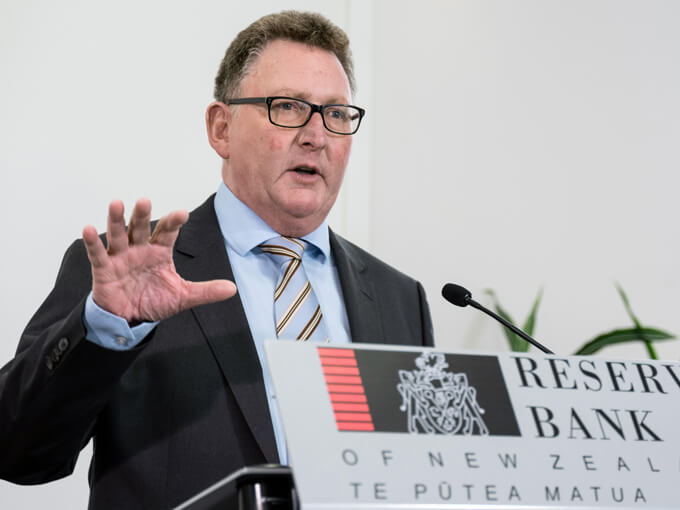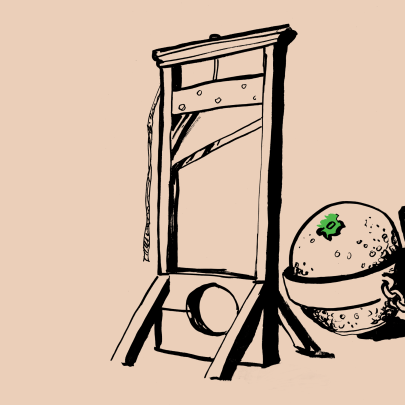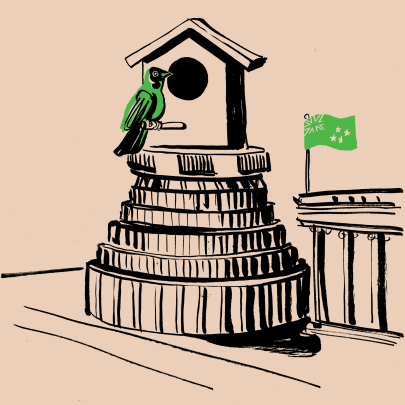Aug 13, 2019 Politics
Today (16 March 2020) the Reserve Bank lowered the Official Cash Rate (OCR) to an historic .25%; an emergency move in the wake of the spread of covid-19. In August last year we published an explainer on what an OCR cut actually means. Economics idiot Tess Nichol has absolutely no idea. So she asked her dad, business journalist Pattrick Smellie, to explain. We’re republishing their conversation now, with a few updates regarding the current situation.
Tess: Hi Dad!
Pattrick: Hi T.
Ok, so – the Official Cash Rate (OCR) cut. What does this actually mean? I know it’s good if you have a mortgage, but what does it mean for me or people like me – aka renters with few savings?
It probably doesn’t mean much for renters with little savings. The market pressures that are sending rents so high are not so much to do with interest rates as scarcity of rental properties and the very large mortgages that some landlords are servicing to buy the houses they’re renting.
For people like me, people with no mortgage and some savings, it means that putting money in the bank is even less attractive than it was before.
The Reserve Bank hopes this will tempt some people to spend more and plump up the NZ economy, which is slowing down.
Or, alternatively, that people will put their money into more productive investments, which are generally higher risk, rather than putting money in the bank, again to stimulate the economy. That’s the theory, anyway.
Right now, shares are taking big hits around the world, partly because people and businesses that need cash right now sell assets to fund their day-to-day cash needs. It’s impossible to know when is the ‘best’ time to buy, but the one thing we can be sure about is that the coronavirus impacts will pass eventually, and share prices should rise when that happens. If you don’t need your KiwiSaver funds or money from share investments right now and are able to wait – maybe a year or more – now is the wrong time to be selling, in my view.
What actually is the OCR?
Every night, there’s a banking system process known as ‘settlement’ in which the trading banks (like BNZ or Westpac) are required by law to deposit money with the Reserve Bank overnight for distribution to other banks, based on whatever transactions all their customers undertook during the day. There’s always a few billion dollars slopping around heading from one place to another.
The OCR is the interest rate that the Reserve Bank pays to the trading banks for holding that money overnight as a cash deposit. Think of it like this – if you put money in your savings account, you get to collect interest from your bank. The same principle applies here, even though the money is only with the RBNZ for a night. The benefit for the RBNZ is this way they get oversight on what the trading banks are up to, and access to money which can be put on deposit elsewhere (like international money markets), to generate revenue for the RBNZ.
As a result, the OCR sets the benchmark for the interest rates that the trading banks charge on loans or pay for savings.
Don’t cash rates get cut when the economy is in trouble? This won’t surprise you, but I’m getting anxious about stuff, particularly another recession, and the possibility of losing my job right about when I want to start planning a family.
How do I answer this simply? There are a few factors at play:
1. Central banks don’t always cut interest rates because there’s trouble ahead, although sometimes that’s the case. The OCR fell from above 8% at the time of the Global Financial Crisis (GFC) to 2.5% in less than a year. That is absolutely unprecedented and indicates the scale of the GFC’s impact.
The reductions since then have taken a decade to occur.
Today’s cut from 1% to 0.25% is the largest single cut ever made to the OCR and indicates just how big a shock covid-19 is expected to produce not only in New Zealand, but for the global economy. Note also that the Reserve Bank says it won’t cut rates again. If it needs to act, it is saying it will start printing money – more politely known as ‘quantitative easing’ – although we are still some distance from that step being taken.
2. Mostly, they cut interest rates to try to encourage inflation. The weird thing about the global economy at the moment is that inflation seems to have disappeared. High inflation used to be the biggest economic problem. Now it’s the absence of inflation. The drastic drop in spending and demand created by the global shock from covid-19 has snuffed out inflation even more than before.
So cutting rates is meant to make it more likely people will borrow and spend and inflation will rise. With so little room between 0% and the current OCR, however, that’s becoming difficult. I.e., the Reserve Bank has very little room to manoeuvre when it gets this close to zero. When the OCR was at 8%, they had lots of ammunition to push rates up or down. At 0.25%, they have very little capacity to go lower, which is why they’re talking about printing money now rather than cutting rates any further.
3. Sometimes, the intention is to send the NZ dollar lower, because that acts as a cushion for exporters. When the dollar’s down, we get more for our exports in other currencies. However, it also pushes up the cost of imports, particularly fuel. In this case NZ could not afford to keep its interest rates up when other central banks around the world are all cutting interest rates in what some economists are describing as ‘competitive devaluation’ to ensure their exports don’t get priced out of the market.
4. As far as recessions go, two thoughts:
Recessions in economies are part of life. Economies tend to move in cycles and the amazing thing about the last 10 years since the GFC is that there hasn’t been a recession. It’s been a particularly long period of growth.
NZ and the rest of the world are definitely now heading into a recession, caused by covid-19. The question is how long it will last. A big part of the reason that governments around the world are taking such drastic measures – NZ is effectively cut off from the rest of the world at the moment apart from freight movements – is to slow and reduce the total number of infections in the hope that containment will allow a bounceback to occur more quickly. There is no certainty about any of this, but the theory is certainly valid. However long it takes, there WILL be a strong bounceback in activity at some stage. The only question is whether it takes three months, 12 months, or longer.
If this cut fails to stimulate the economy, then what happens? Are we in trouble?
We have high levels of household and farm debt, which is worrisome if interest rates were ever to rise much. But the government’s books are almost absurdly strong. We have some of the lowest government debt levels in the OECD. In the event of a recession, that gives the government room to spend more and ‘lean against’ economic bad times. Not many other countries have that luxury.
The government’s willingness to spend money to keep the economy moving is the most important factor to consider right now. That is going to be far more important than anything the Reserve Bank does to interest rates in this situation. The details will be out tomorrow and a multi-billion package is expected. This is what will make the biggest difference to how deep the recession is, although it won’t affect its length. That is down to the virus and how well it can be contained.
And are you saying boom and bust is just… an unavoidable fact of life? What about everyone who’s the victim of that though? It doesn’t seem fair.
Governments can try to make economies fairer, but economies do tend to wax and wane and no one can predict a new, global pandemic. Some of it we can’t control. If there’s a long drought or something like that, an economy with a lot of exposure to agriculture will do worse. In a good year, it will do better. Things get a bit tighter for a while, then they get a bit better. The issue at the moment is how long this will last and how deep the recession will be.
What are the chances of interest rates rising again, and saddling those with floating mortgages with more debt than they can repay? Relatedly, if markets are cyclical, when will the Auckland housing market experience a bust to balance the boom of the 15 or so years? Or have external factors broken the cycle? TL;DR: if you can’t afford a house now, will you ever be able to afford a house?
We are stuck with very low interest rates for a very long time. If they did rise, it would hurt anyone on a very big mortgage quite quickly. However, no one I talk to sees interest rates jumping back to an OCR of 8% or anything like it in the foreseeable future – i.e., the next decade or more. They could be wrong, of course, but it’s really hard to see.
Bear in mind two things:
1. Not everyone borrowed for their house during the latest boom – only a proportion of borrowers have huge mortgages (and many people either bought in other centres or have moved out of Auckland to find somewhere less expensive).
2. Very low interest rates make it possible to service a very large mortgage. When we bought the house you were born in, we borrowed about $100,000, but interest rates were 20% a year. That’s equivalent to borrowing $500,000 at 5% today.
On Auckland house prices, they have already settled back quite a bit in the last year. This is the preferable way for a boom to end – with a slowdown and some backtracking, rather than a bust.
I would be more concerned about an earthquake, volcano or a prolonged recession that causes widespread small business failures causing a property price bust in Auckland than interest rates or, if you own property on a beachfront, a collapse in demand and insurability as climate change bites.
Thanks for explaining! Love you x
Love you too.
Pattrick Smellie is a founder and business journalist at BusinessDesk, with more than 35 years’ experience in journalism and corporate public relations. He’s also Metro digital editor Tess Nichol’s dear old dad. You can subscribe to BusinessDesk for just $24 a month.






